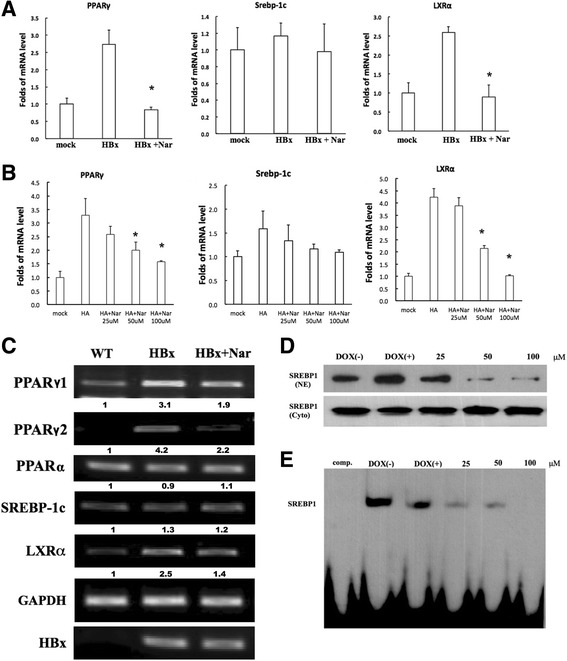Fig. 4.

The effect of naringenin (Nar) on the expression of genes associated with lipogenesis in the HBx-transgenic livers. a Expression of the mRNAs encoding PPARγ, SREBP1-c, and LXRα in the livers of wild-type (WT) mice and in the livers of HBx-transgenic mice without and with 14 days of once-daily Nar treatment (30 mg/kg/d), as assessed by RT-PCR. b Expression of the mRNAs encoding PPARγ, SREBP1-c, and LXRα in HepG2 cells that had been mock-transfected (mock), or stably transfected with the HBx-GFP construct (HA) and grown in the presence of 0, 25, 50, or 100 μM Nar, as assessed by real-time PCR. c Repeat of the experiment portrayed in Panel A, this time using reverse transcription-PCR. Amplification products were electrophoresed, stained with ethidium bromide, and visualized using a transilluminator. d Nar attenuates HBx-induced nuclear translocation of the SREBP1 protein in HepG2-HBx cells. HepG2-HBx cells were grown in the absence of inducer (DOX(−)) or in the presence of inducer and Nar at 0 (DOX(+)), 25, 50, or 100 μM Nar. After 24 h of growth, cells were harvested, and the nuclear extract (NE) and cytoplasmic (Cyto) fractions were generated and processed for immunodetection of the SREBP1 protein as described in the Methods section. e Nar attenuates HBx-induced activation of the SREBP1 protein in HepG2-HBx cells. Cultures were grown as in Panel d, and samples collected after 24un hours were processed for biotinylated electrophoretic mobility shift assays as described in the Methods section. For Panels a and b, data are presented as mean ± SD from each group of 5 animals. Asterisk indicates a significant difference (p < 0.05 by two-tailed unpaired t test) comparing HBX mouse ± Nar or HepG2-HBx ± Nar. For Panels c, d, and e, reactions were performed with samples from individual mice or cultures; results are representative of those seen for biological replicates
